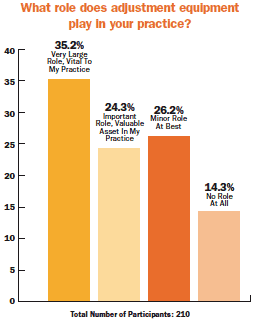In a recent Dynamic Chiropractic PracticeINSIGHTS poll, we asked doctors of chiropractic: "What role does adjustment equipment play in your practice?" Nearly 60 percent of the 210 doctors who participated in the poll said that adjustment equipment plays a very large or important role in their practice.
However, while the majority of the poll takers say they use adjustment equipment in their practices, hardware is only a part of a treatment process in which manual adjustments are still crucial to most practitioners.
For example, Robert Keroson of South Carolina wrote: "When I hear 'adjustment equipment,' I think of mechanical instruments to perform an adjustment. When I put my hands in the equation, it becomes a vital role. One example of when I use a mechanical instrument is on a patient with osteoporosis, in the area of subluxation."
 Within the chiropractic treatment environment, "adjusting equipment" obviously can mean anything from an adjusting in-strument to special tables, but clearly most of those who gave us additional responses were describing their use of tables.
Within the chiropractic treatment environment, "adjusting equipment" obviously can mean anything from an adjusting in-strument to special tables, but clearly most of those who gave us additional responses were describing their use of tables.
Scott Stephenson, of Grand Blanc, Mich., had a fairly typical comment: "I perform a lot of flexion-distraction and Thompson technique on patients."
And Robert Chatfield, of California, explained: "I use a flexion-distraction-decompression table in one of my offices, but that is the extent of it."
That said, tables, while apparently the most popular form of equipment among our respondents, are by no means the only such equipment that practitioners use, including on themselves.
"I don't know where I would be with out the TepperWedge for Anteriorities," said Ron Grassi, of Jupiter, Fla. "Over the past 24 years, it has saved the carpal bones in my left wrist."
Then there are those who forego hardware altogether in favor of manual work.
As one example, Donald Ferrante of Portland, Ore., wrote: "I adjust the spine by hand. I was trained that way more than 35 years ago and it works best for me."




